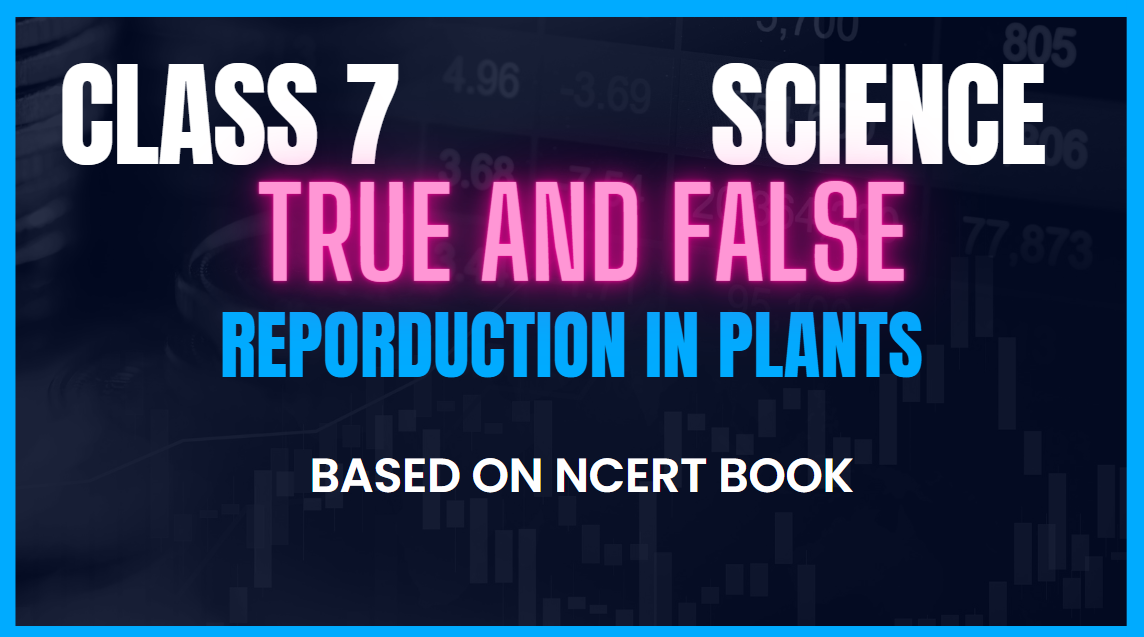1 All living organisms have the ability to produce new individuals.
Answer: True
Explanation: The production of new individuals is a characteristic of all living organisms.
2 Reproduction in plants can only occur through the production of seeds.
Answer: False
Explanation: Plants can reproduce through both asexual and sexual reproduction. Asexual reproduction does not involve the production of seeds.
3 Flowers in plants serve the purpose of reproduction.
Answer: True
Explanation: Flowers perform the function of reproduction in plants.
4 Asexual reproduction in plants involves the production of seeds.
Answer: False
Explanation: Asexual reproduction in plants does not involve the production of seeds.
5 Vegetative propagation is a type of sexual reproduction in plants.
Answer: False
Explanation: Vegetative propagation is a type of asexual reproduction, not sexual reproduction.
6 : Nodes are parts of a plant where flowers develop.
Answer: False
Explanation: Nodes are parts of a stem/branch where leaves arise, not where flowers develop.
7 Vegetative buds can give rise to new plants in some plant species.
Answer: True
Explanation: Vegetative buds can give rise to new plants in certain plants.
8 Sweet potato and dahlia can reproduce by producing seeds.
Answer: False
Explanation: Sweet potato and dahlia can give rise to new plants through their roots, not by producing seeds.
9 Plants produced by vegetative propagation are genetically different from the parent plant.
Answer: False
Explanation: Plants produced by vegetative propagation are exact copies of the parent plant.
10 Yeast reproduces through sexual reproduction.
Answer: False
Explanation: Yeast reproducing through sexual reproduction.
11 Yeast cells reproduce through fragmentation.
Answer: False
Explanation: Yeast cells reproduce through budding, not fragmentation.
12 Algae multiply rapidly by breaking up into fragments.
Answer: True
Explanation: Algae grow and multiply rapidly through fragmentation.
13 Fungi on a bread piece grow from spores present in the air.
Answer: True
Explanation: Fungi on a bread piece grow from spores, which are present in the air.
14 The female reproductive part of a flower is called a stamen.
Answer: False
Explanation: The female reproductive part of a flower is called a pistil.
15 Flowers that contain both stamens and pistil are called unisexual flowers.
Answer: False
Explanation: Flowers that contain both stamens and pistil are called bisexual flowers, not unisexual flowers.
16 The anther of a stamen contains pollen grains.
Answer: True
Explanation: The anther of a stamen contains pollen grains.
17 The ovary of a pistil contains pollen grains.
Answer: False
Explanation: The ovary of a pistil contains ovules, not pollen grains.
18 In sexual reproduction, a zygote is formed when a male and a female gamete fuse.
Answer: True
Explanation: A zygote is formed through the fusion of a male and a female gamete in sexual reproduction.
19 Yeast cells can be observed under a microscope.
Answer: True
Explanation: Yeast cells can be observed under a microscope to observe the formation of new yeast cells.
20 Moss and ferns reproduce by means of budding.
Answer: False
Explanation: Moss and ferns reproduce by means of spores, not budding.
21 Pollen grains can be carried by wind, water, and insects.
Answer: True
Explanation: Pollen grains can be dispersed by wind, water, and insects.
22 Self-pollination occurs when pollen lands on the stigma of a different plant.
Answer: False
Explanation: Self-pollination occurs when pollen lands on the stigma of the same flower or another flower of the same plant.
23 Fertilization is the process of fusion of male and female gametes.
Answer: True
Explanation: Fertilization as the process of fusion of male and female gametes.
24 After fertilization, the ovary grows into a seed.
Answer: False
Explanation: After fertilization, the ovary grows into a fruit, not a seed.
25 Seed dispersal helps plants prevent overcrowding and avoid competition.
Answer: True
Explanation: Seed dispersal helps plants prevent overcrowding and avoid competition for sunlight, water, and minerals.
26 Vegetative propagation involves the fusion of male and female gametes.
Answer: False
Explanation: Vegetative propagation does not involve the fusion of male and female gametes. It refers to the production of new plants from vegetative parts like leaves, stems, and roots.
27 The flower is the reproductive part of a plant.
Answer: True
Explanation: The flower is the reproductive part of a plant.
28 Cross-pollination occurs when pollen grains are transferred to the stigma of the same flower.
Answer: False
Explanation: Cross-pollination occurs when pollen grains are transferred to the stigma of another flower of the same kind, not the same flower.
29 Fertilization results in the formation of an embryo.
Answer: True
Explanation: The passage states that the zygote resulting from fertilization develops into an embryo.
30 Seed dispersal is aided by wind, water, and animals.
Answer: True
Explanation: The passage mentions that seeds and fruits are dispersed by wind, water, and animals.
